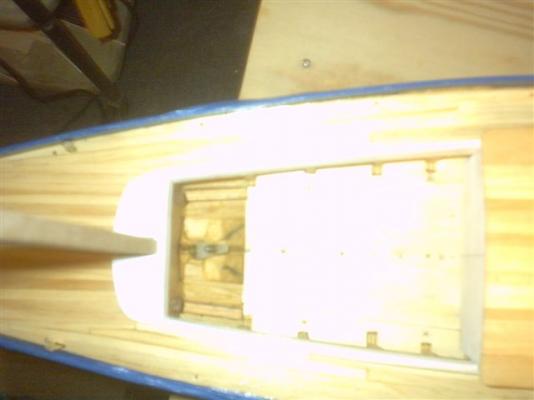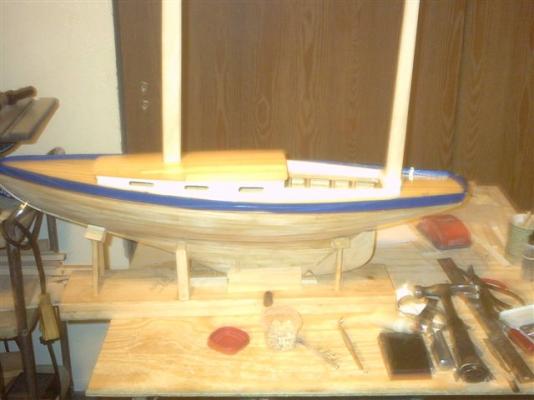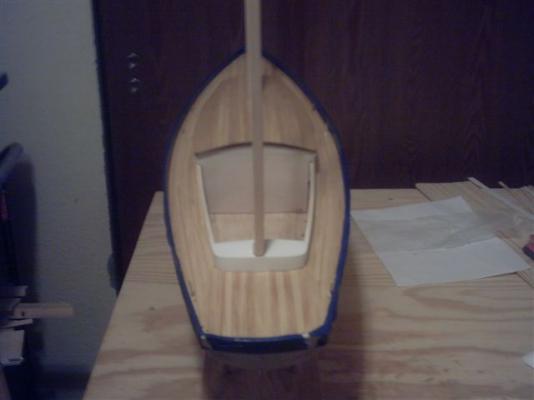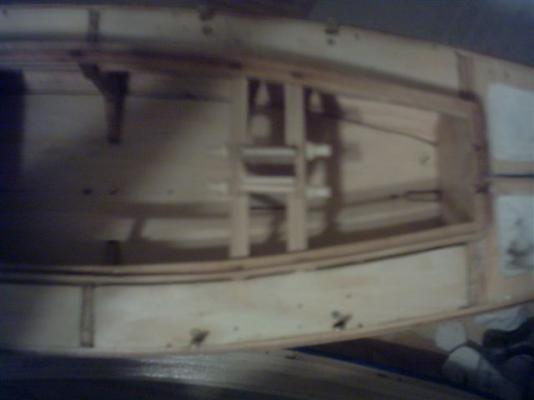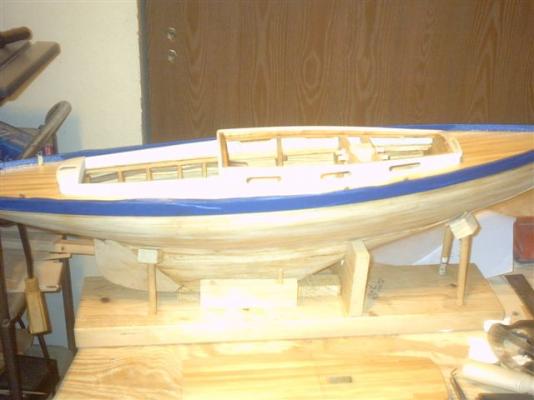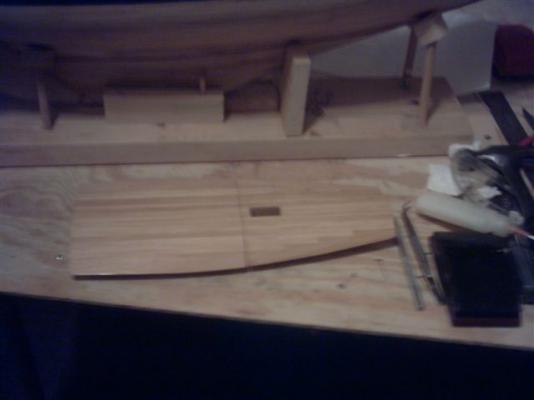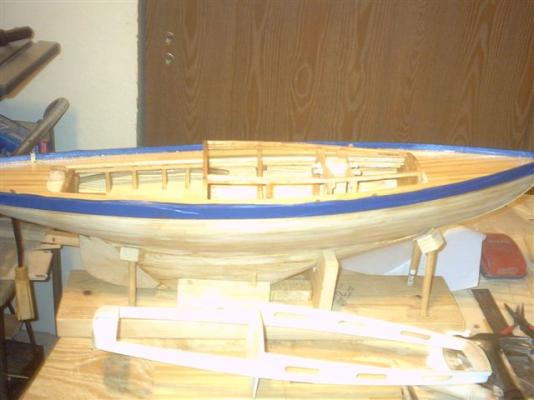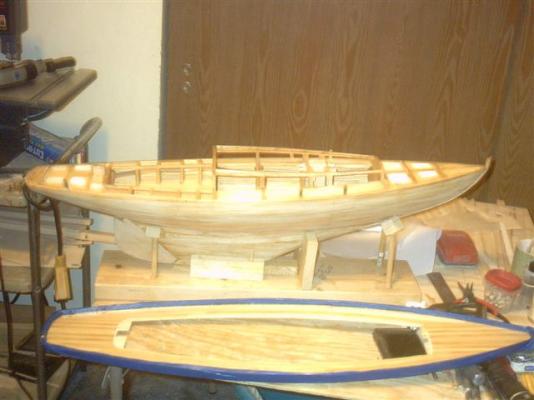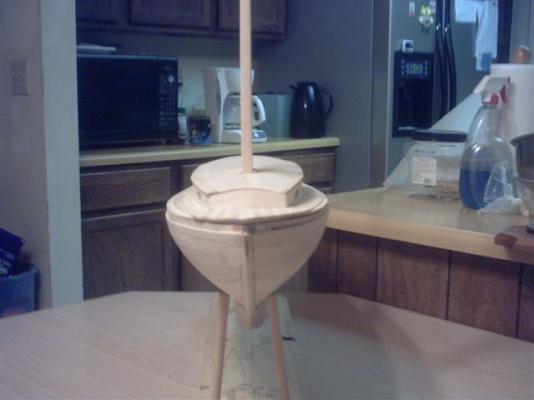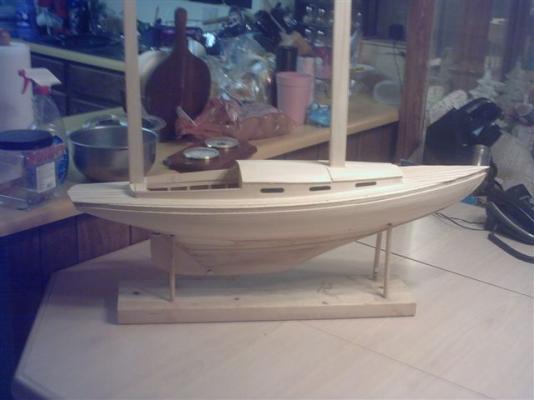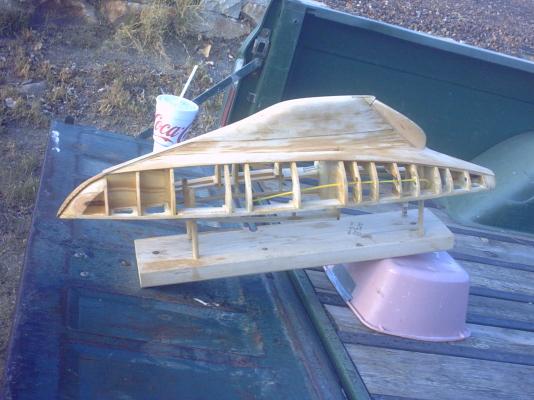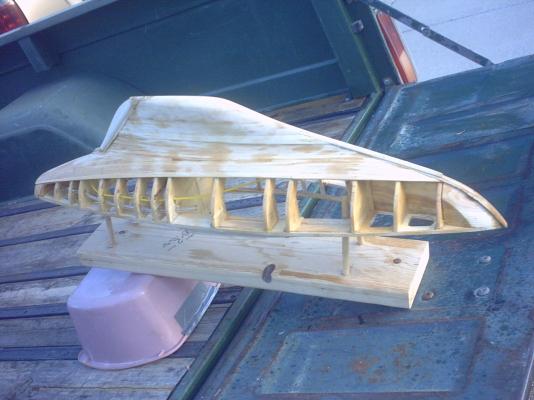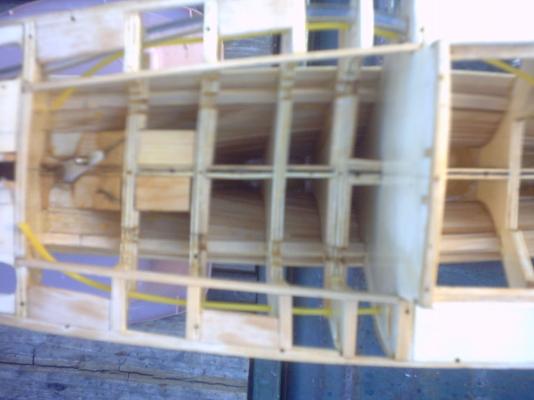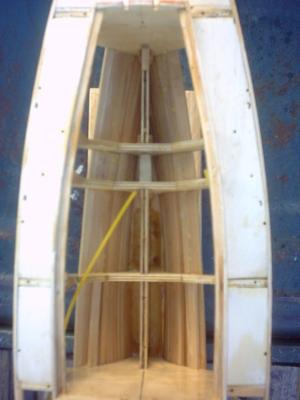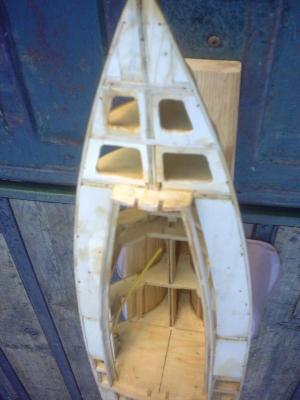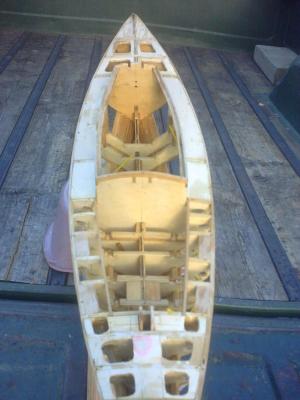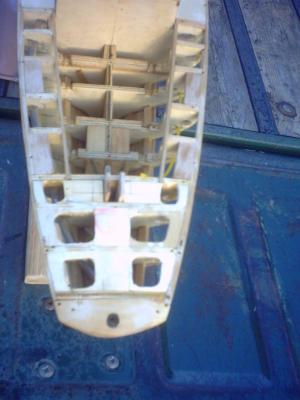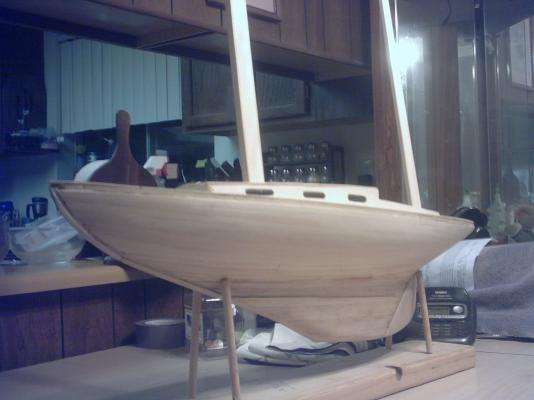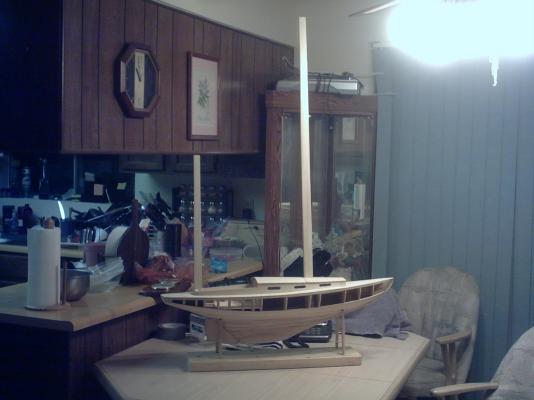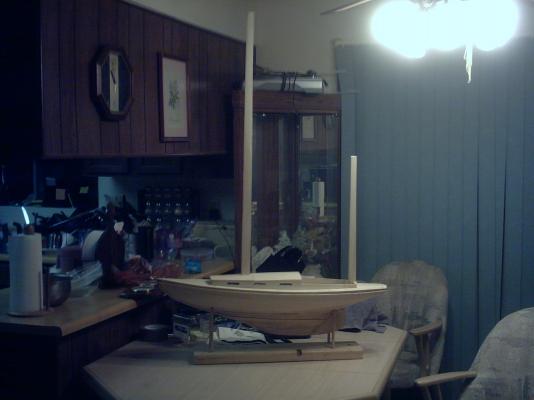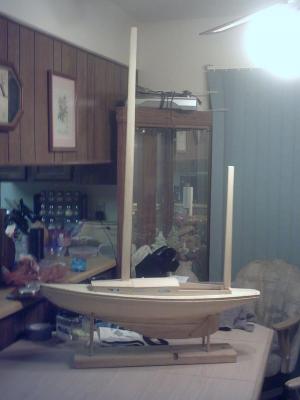-
Posts
356 -
Joined
-
Last visited
Content Type
Profiles
Forums
Gallery
Events
Everything posted by Walter Biles
-
Thank you Bob. I've been fabricating a cockpit assembly. A sloped floor into a sump with seats and the wheel. I may put a deck grate so the water can drop through into the floor and run off into the sump around the rudder shaft. That had a drain down to just above the water line with a check valve on it on most of those small sailboats we had there. I'll have to water proof the sump so the water can't spread out in the hull. Lots of ideas. Walt
- 208 replies
-
- meridea
- repair ship
-
(and 1 more)
Tagged with:
-
Bob, I seem to recall from my navy days, that when reporting aboard, before you stepped off the gangway, you saluted the Quartermaster and asked permission to come aboard, and when answered in the affirmative, you faced aft and saluted the colors, which when getting underway, were moved to the masthead. This may explain the after flag staff, and it's apparent interference with the aft boom. It probably had a place to be stowed when underway. Walter Biles
-
Thank you very much, Popeye. Man, It took me over an hour just to get the pictures posted and labeled, and I didn't get them in the order I intended. This posting stuff is the hardest for me. . Walter Biles
- 208 replies
-
- meridea
- repair ship
-
(and 1 more)
Tagged with:
-
Sorry to be so behind on all my posts. I have been busy working on the boat. First, I finished planking the inner layer completely. Then I fabricated the waterways and gunnels all around. Then I re-adjusted the cabin roof clearance to the cabin and planked the deck, and the cabin roofs. I have the cabin window assembly where it fits inside the planking of the deck completely. I finished the fence around the cockpit to keep the water out of it. That is now an assembly that fits around the cabin frame which is integrated into the hull. I put a clear coating on the decking and roofs. I am using Minwax Polyurathane. It is the first time I have used the water cleanup formula. I hope it will sand out smoother than the first coat did. It sure makes that decking look nice color-wise. I have removed all the top deck and other assemblies, and spent a couple days drying out the boiled linseed oil that I poured inside of her. I let it set for a bit, then rolled the puddles into all the framework, and then put it upside down over a big drip pan, to drain for awhile. Then I recovered the leftover linseed oil, and put it back into the can for my next project. I put the hull in the stand and set it in my truckbed where the sun could get at the inside of it with the gentle breezes to dry. I am lucky I did it when I did, because just after I got it dry, the rains came back. It takes good dry air and sun to get a good coating dried inside. I tried that spray foam for sealing cracks around windows, but am going to have to remove it and try again. I wanted floatation, and that is not it. I still have not finished the second layer of planking, but as soon as I get that done, I can now ballast. Once both the ballast and the floatation are in, I can start putting back on all the assemblies permanently When it is all assembled, it really looks nice. I will try to get pix of everything and insert them into the text parts where I described it. #1 This one is down into the cockpit area. It shows the rudder and that's about all. The blue stuff is tape screening the bulwark so it can still have the inner lining put on to seal against the deck. #2 This is the port side of the boat assembled as far as I've gotten. #3 This is an elevated view from the aft showing the roof and deck planking. #4 Starboard side view with Roof off of cabin #5 Roof #6 With the cabin/cockpit assembly off. The after most part of this surrounds the mizzen mast. . #7 Showing with the deck off the subdeck. #8 This next one is of the main mast frame bracing Walter Biles
- 208 replies
-
- meridea
- repair ship
-
(and 1 more)
Tagged with:
-
I have cut the outer transom piece and installed all of the tiedown anchors in the deck. I did have to true up the masts. I have a couple of more secondary planks done on the hull, and have been fitting the gunnels and locating the waterways. It won't be a copy of the original Meridea, but you can recognize her lines. The most recognizable feature she has is the rectangular masts. I can't believe how strong they are. Once I get some guy wires for the stays, and make the spreaders, I believe she will be able to take a blow! I'm getting excited at the progress I've make. I'll need to get some more pictures. I get so involved in what I'm doing, I forget. Any one know where I can find some functional turnbuckles to adjust her mast stays? Do any RC'rs out there know if using fine cable for the stays will mess up the radio functions now-a-days? The boat is beginning to get pretty solid. I've dropped her on my foot while I was working on her, and it really hurt. It didn't do anything to the boat, but my foot hurt for several days. Well, I better go ahead and get to bed. I was up all night yesterday working on the boat, and I'm getting tired. Walter Biles
- 208 replies
-
- meridea
- repair ship
-
(and 1 more)
Tagged with:
-
Thanks Popeye, Cap'n Bob. I am currently working on making the stand more supportive. I have cut down the height of the stand legs, so I can have the keel nestled in a brace to keep it from wobbling side to side. I've been watching Michael and find that I may need to firm up the hull on the stand so that I can true up the masts plumb. I had better get it where it will stay in one place while I check it out. After fairing the deckline, I may find that I can no longer find level across the gunnels. I have been noticing some apparent inequities of spacing on deck features that got me wondering. I believe I can still correct masts to hull alignment if it has strayed. I left the top of the mast base sheaths loose, so I can shim them over if necessary at this stage. I wish I had had a better idea of the hull shape before I started construction so I could have made a jig to build the whole thing in. I just hope my original cad frames were all accurate and that accuracy will be holding the form true. Gotta run. Walt biles
- 208 replies
-
- meridea
- repair ship
-
(and 1 more)
Tagged with:
-
Here are the most recent pictures of my Meridea. I finished the inner planking, I made the masts, and have them fitted, I worked on planking the deck. I used pine. Here is a side view. An aft view of the deck. A front view. I have gone about as far as I can go until I get the second planking finished so I can do the ballasting. Then I can start glueing the decks and cabins on and finish the cockpit. At the end of most of that I need to add the waterway planking so it will extend out through the planking, and put on the top planking. I am extending it up above the deck and making the waterways through it. It will act as a toerail along the edge of the deck. The original had fiberglassing on hull, deck, and cabin including the roof. It had a mahogany toe-rail just inside the edge of the deck, with the stanchions for the safety line around inside it. I had to create a heavier frame for the stanchions to attach to, so I am putting the toe- rail as part of the top course of planking. Walter Biles
- 208 replies
-
- meridea
- repair ship
-
(and 1 more)
Tagged with:
-
Foremast, I have been reading through your build. You show some pictures from a museum of some cannon. It appears that there is an opening oval in the top with a filler bar to fit in the breach. That and the handle grip on top of the bar makes me wonder were those early breech loading cannon? There even appears to be a wooden block behind the bar for recoil stop. Walter Biles
-
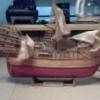
Band or scroll saw?
Walter Biles replied to amateur's topic in Modeling tools and Workshop Equipment
@ Merideth, Shops always want you to get bigger and more expensive so they can make more. I have a 10" band saw and it will cut a block up to 3" thick. That should be wide enough for sheet material. In addition I rip the sheets down after sanding them a bit, and make planking strips with it. Even with my 3/8" blade on it, I can cut pretty intricate shapes. You just need to decide if that is within the size parameters you need to work. You can clamp a straight plank parallel to the blade for a rip fence. 2 small clamps and a ruler and a trial cut or two, and you will be cutting all the stock you want. Sorry about not getting back for your July 25 post, but I could not remember where to find it. Walt Biles -
Mark, Thank you for that book mark. I have added it to my favorites. Now I have a place I can go for those nautical terms that I never learned the meaning of. Popeye, "the longitudinal curve of a ship's deck or sides." It seems to be describing the curve along the length of the deck, or the side of the boat. Well, "Blow me down". Another one I might be able to remember next time. In the SeaBees, our training had "sheers" as being a pair or more of posts set together and bound at the top and set on ends and anchored by guy ropes anchored by triple staking in all directions, to use as a lifting boom for bridge timbers or other heavy loads. That was what had me confused. I couldn't think of it in a nautical terminology. I guess if using it, it appears to mean "curves" as applied to the fore to aft lines of a deck, or a boat's shape. Does that sound about right? Thanks for the compliment about my boat, Popeye! Walt Biles
- 208 replies
-
- meridea
- repair ship
-
(and 1 more)
Tagged with:
-
Popeye, I just couldn't remember if I ever knew what the sheer was. I looked in wickipedia, and it seemed to me they were describing the crown in the main deck, but like I said, I can't ever remember using the term or knowing what it meant. I think most of my coworkers in R-Division were too recently land lubbers (like me). I learned a lot of terms, but never got them nailed down in my mind through use like I should have if I had actually had to work on deck with the nomenclature and doing the work. I cross rated to SeaBee before I got into active duty. Walt Biles
- 208 replies
-
- meridea
- repair ship
-
(and 1 more)
Tagged with:
-
Popeye, Pardon my forgetfulness, but is the sheer, the upward curvature of the deckline? Walter Biles
- 208 replies
-
- meridea
- repair ship
-
(and 1 more)
Tagged with:
-
Well I got the rest of the first planking on. I only have a top plank to put on around the sides. I am going to make it 3" taller (original scale) than the deck level for a toe rail, and put waterways through it to carry off any deck wash. I am glueing in some filler pieces onto the first planking to correct some irregularities so the contours will be more even. My masts came out a lot straighter than the plywood I used. I had to assemble it on a board to hold things straight until I got the pieces all joined together. Once I got them all sanded down, they held their shape when I swung them to see how much they would flex. Front to back was nil for flexing. Side to side allowed them to bow a little, but the shrouds and braces should keep them in check. I believe they should work okay. I built them up from 1/8" plywood, and used a 5/16" to 3/32" tapered 1/8" strips inside the plywood, and doubled that to the outside for the outer facings. I filled about each 5 - 6" with blocks for strengthing and rigidity, and placed substantial blocks where the external braces and or other attachments would need backing. I did not try to emulate the internal line handling feature. I added side to side bracing timbers across the cabin in front and back of the mast, making notches on each side of the mast to hold it securely. This should help take any strain that the mast might try to put on my cabin roof. It also helps to keep things in line. The centerline of both masts are parrallel at 15 3/4" top to bottom. Both appear to be directly in line with one another down the centerline of the boat. I'll get some pictures later. Walt biles
- 208 replies
-
- meridea
- repair ship
-
(and 1 more)
Tagged with:
-
Greg, Yes that was the way they were shaped. I drew the proportions of them off the boat using the inches of width and height from the seawall some way off. I transferred the dimensions from my ruler at arms length right onto the paper. I think it was a special made boat to try out some different things. For instance, the running lines for raising the sails ran to the inside of the masts. I think they may have had special gear to operate them. There were beaded slide pins that attached the sails into a track that ran up the back of the masts. I had seen one man bring in the boat, and the sails just seemed to let down. I never saw any crew working lines, except to throw the heaving line to him so he could tie to the posts on each side of the slip. I did see a group go out with him one time, but I never saw anyone do anything except cast off the lines from the dock. They mostly seemed to be along for the ride. That was what intregued me about the boat. She handled beautifully. He did not even seem to have a motor in use for the docking. He just pushed off with a long boat hook, to get the boat out of the slip and up went the sails and he was under way. I wish I had asked if I could go aboard her and look her over more completely. Although some boats were off limits, I never tried to see if I could get permission. I did get a work order to replace a cleat on the aft boom of the America replica which was in the slip next to her. A wind the night before strained the cleat which split, and I made a new oak one and put it on the boom after repairing the holes from the screws. That was the only time I was allowed on America. I did not even get to look around her. She was up for sale even then. I heard she sold much later. She had been repainted white for that tall ships parade in 1976. Walt Biles
- 208 replies
-
- meridea
- repair ship
-
(and 1 more)
Tagged with:
-
Thank you for stopping by, Popeye, I still have 5-7 strakes to go on the starboard side, and amost of the secondary planking to go. I have been working on mast bracing in the cabin. It is still temporary until I get the rest of the planking done so I can ballast. I am beginning to get a bit excited about it. Walter Biles
- 208 replies
-
- meridea
- repair ship
-
(and 1 more)
Tagged with:
-
Thanks, Bob. I had lost my camera download cable for a spell. I took pictures but until I found it, finally, I had no way to get them to the site. If I can get back into the planking, I could get ready to ballast it, then I could start permanent installation of the decks, cabin, and the cockpit. I am going to have to make my own wheel for steering. I guess silver solder could serve for the chroming on the wheel and housing. I think thats what I will do for the stantions and railing. It would not be too long before I will have to be making all the rigging hardware. Do you know how to solder? I may need some guideance on the how-to part of that. Walt Biles
- 208 replies
-
- meridea
- repair ship
-
(and 1 more)
Tagged with:
-
These first seven pictures are with all the loose assemblies removed for painting boiled linseed oil on the inside of the lower planking . After I got the hull dried out, and did some more planking, I now have the hull fully planked on the port side with the first layer, and up to five or six strakes on the starboard side. I already had the second layer of planking with a denser Basswood of 1/16" thick on the keel ballast bulb to reinforce it for balasting. Tonight I built the masts. They are 1/8" plywood, with basswood block fillers between and edge spacers to provide the tapering. I capped the front and back of them with another 1/8" Basswood piece for the front and back edge of each mast. All of the strip pieces have staggered joints so there will not have a weak point. This brings me up to date. Walter Biles
- 208 replies
-
- meridea
- repair ship
-
(and 1 more)
Tagged with:
-
Great work, Bob. I love those little details. I took my optivisor and checked it out. Really neat! Walt
-

Band or scroll saw?
Walter Biles replied to amateur's topic in Modeling tools and Workshop Equipment
Sinan, I have gotten much happier about this Craftsman 10" 3 wheel bandsaw since I found out why the band kept jumping off at practically every use. I found out that the tires had stretched out a bit, and one was fairly loose. After swapping it to a carrier wheel, and contact cementing all the tires in their tracks, It seems to be a model machine. I can rip off 3" planks with a rip fence added, and cut strips off of the planks to the size I need. I am not working in micro size strips, so it is a big help. I just sand the stuff with a block and strip it. I had once considered junking it until I discovered how loose the tire was. Centrifugal force was raising up the edges and letting it move in the groove. Once it slipped up on the retainer ridge, the band would jump off the wheel. It is dreadfully difficult to get back on all 3 wheels at the same time. Thankfully I seldom have to do that any more. It has become my favorite tool since then, and it runs the quietest of any of my other tools. I just about do all my cutting with it now. Walt Biles -

Band or scroll saw?
Walter Biles replied to amateur's topic in Modeling tools and Workshop Equipment
There is another consideration about the band saw. You can never cut out the middle of a circular piece, without cutting in through the edge. With a scroll saw, you can drill a hole through the middle, and then take the blade loose from the scroll saw, and insert it through the hole, re-install the blade, and cut out the inside. Then just remove the blade and release your piece. For scroll saws, you can get blades that will cut in any direction due to them having teeth all the way around like a round file, only very fine. Also, there is usually a difference in the depth of cut on each of the two types of saws. It depends if you will only be cutting something an inch thick, or maybe 3 inches or more thick. Both saws have another measurement that effects how long a piece you can cut off of a piece, called the throat. That means how far back from the blade can you slide the work before it hits the upright part of the saw. All are considerations. The special round blade for the scroll saw can be nice for that, because you don't have to rotate the board around the blade past that upright like you would for a band saw. Having a 10" band saw, I can't cut off a square cut piece longer than that 10" space between the channel for the blade where it goes up, and where the blade comes back down to cut. Scroll saws often have 15 - 16" of throat, although some may be less or more, depending on manufacturers and what they want them to do. I hope that this may help you make a more informed decision. Walter Biles
About us
Modelshipworld - Advancing Ship Modeling through Research
SSL Secured
Your security is important for us so this Website is SSL-Secured
NRG Mailing Address
Nautical Research Guild
237 South Lincoln Street
Westmont IL, 60559-1917
Model Ship World ® and the MSW logo are Registered Trademarks, and belong to the Nautical Research Guild (United States Patent and Trademark Office: No. 6,929,264 & No. 6,929,274, registered Dec. 20, 2022)
Helpful Links
About the NRG
If you enjoy building ship models that are historically accurate as well as beautiful, then The Nautical Research Guild (NRG) is just right for you.
The Guild is a non-profit educational organization whose mission is to “Advance Ship Modeling Through Research”. We provide support to our members in their efforts to raise the quality of their model ships.
The Nautical Research Guild has published our world-renowned quarterly magazine, The Nautical Research Journal, since 1955. The pages of the Journal are full of articles by accomplished ship modelers who show you how they create those exquisite details on their models, and by maritime historians who show you the correct details to build. The Journal is available in both print and digital editions. Go to the NRG web site (www.thenrg.org) to download a complimentary digital copy of the Journal. The NRG also publishes plan sets, books and compilations of back issues of the Journal and the former Ships in Scale and Model Ship Builder magazines.


